Reponses of Tomato (Lycopersicon Lycopersicum Mill), Soil Temperature and Soil Moisture Content to Mulch Material and Mulching Rate in Ogbomoso and Mokwa, Nigeria
Tswanya MN1, Olaniyi JO2 and Alamu LO3
1Biotechnology Advanced Research Centre, Nigeria
2Department of Agronomy, Ladoke Akintola University of Technology, Nigeria
3Department of Crop Production and Environmental Protection, Ladoke Akintola University of Technology, Nigeria
Submission: August 27, 2017; Published: October 27 , 2017
*Corresponding author: Tswanya MN, Biotechnology Advanced Research Centre, Sheda Science and Technology Complex, P.M.B. 186, Garki-Abuja, Nigeria, Email: ndamayakimatthew@gmail.com
How to cite this article: Tswanya MN, Olaniyi J, Alamu L. TReponses of Tomato (Lycopersicon Lycopersicum Mill), Soil Temperature and Soil Moisture Content to Mulch Material and Mulching Rate in Ogbomoso and Mokwa, Nigeria. Curr Trends Biomedical Eng & Biosci. 2017; 10(2): 555783. DOI: 10.19080/CTBEB.2017.10.555783.
Abstract
Field experiments were conducted at the Teaching and Research Farm, Ladoke Akintola University of Technology, Ogbomoso and Niger State College of Agriculture, Mokwa, in 2014 cropping season to examine the effects of mulch materials and mulching rates on fruit yield, soil temperature and soil moisture content of tomato variety. The experiment had fifteen treatments viz: three mulch materials (rice husk, groundnut shell and dry guinea grass) and five mulching rates (0, 5, 10, 15, & 20 in t ha-1), replicated three times. The experiment was laid out as split plot arranged in Randomized Complete Block Design. Data were collected on plant height, number of flowers, number of fruits and total fruit yield. Two environmental factors (soil temperature and soil moisture content) were determined. Data was analysed using analysis of variance (ANOVA) SAS package and treatment means compared using least significant difference (LSD) at 5% probability level. Mulching is beneficial to performance of tomato. Mulch types had no effect on fruit yield of tomato. Plants mulched with 15 t ha-1 produced the highest yield (23.30t ha-1) while control plots had the least value (8.13t ha-1). Soil temperature was best at mulching rate of 15t ha-1 and soil moisture content was at 20t ha-1. It could be concluded that mulching is beneficial to tomato production; mulch rate of 15t ha-1 performed better than other rates evaluated and could be recommended for the farmers within the study areas.
Keywords: Tomato; Mulching material; Mulching rate; Growth; Yield; Soil temperature; Soil moisture content
Review Article
Tomato (Lycopersicon lycopersicum) belongs to the solanaceae family. It originated in Peru and Mexico, in the present day Central and South America from where it spread to other parts of the world [1]. Tomato reached Europe from Mexico in the 16th century, and was initially used as ornamental plant. Its cultivation for edible fruits started at the end of the 18th century. Tomato was introduced to West Africa and Nigeria in particular, at the end of the 19th century [2]. It is currently considered to be one of the main vegetable crops in the world, and constitutes an economic force that influences the income of many growers in the world [3]. In Nigeria tomato also finds its way into almost every kitchen. Tomato crop is very important in terms of diet and economy in Nigeria both during the rainy season (rainfed) and dry season using irrigation facilities. It is used as a condiment in stews and soup or eaten raw in salads. Industrially, the crop is made into puree, sauce, paste and powder [4].
Mulching is the process or practice of covering the soil/ground to make more favorable conditions for plant growth, development and efficient crop production. Mulch technical term means ‘covering of soil’ [5]. While natural mulches such as leaf, straw, dead leaves and compost have been used for centuries, during the last 60 years the advent of synthetic materials has altered the methods and benefits of mulching. When compared to other mulches plastic mulches are completely impermeable to water; it therefore prevents direct evaporation of moisture from the soil and thus limits the water losses and soil erosion over the surface [6]. In this manner it plays a positive role in water conservation and the suppression of evaporation also has a supplementary effect; it prevents the rise of water containing salt, which is important in countries with high salt content water resources [7].
Mulching is a layer of material on the surface of the soil used to keep soil moist or to serve a wide variety of other purposes. Organic mulches are those derived from the dead plant and animal tissues, which apart from soil protection also serve as nutrient sources when they decay. Tomato plants subjected to mulching and fertilization exhibited the highest plant height when compared with the other treatment combinations [8]. Mulching has been identified by many researchers as a method to provide a favorable soil environment by minimizing crusting at the soil surface and keep it stable [9]. Influence of mulching on tomato production has been reported by many researchers [10]. This practice increases the infiltration of rain water and suppresses the growth of weeds. Mulching is effective in reducing evaporation, conserving soil moisture and has been known to modify the hydrothermal regime of soil [11].
Mulching of tomato plants with Tithonia diversifolia leaves and fertilizer application together promoted growth and development i.e. number of nodes, number of leaves and height, as well as fruit production i.e. number of fruits, number of seeds per fruit, fruit size, fruit shape and duration of fruiting activity. In the experiment conducted by [9], three tomato varieties namely, Ratan, BARI tomato-3 and BARI tomato-6 were experimentally evaluated to identify the potential mulch on growth and yield, where the experiment consisted of four mulching treatments: water hyacinth, straw, am-ada leaf and banana leaf with a control (no mulch). The experiment was conducted under rainfed condition. The result showed that mulching significantly had effect on growth, yield components and thus on the yield of tomato. Mulching is effective in reducing evaporation, conserving soil moisture and has been known to modify the hydrothermal regime of soil [11]. The bad effects of water deficit could be overcome by irrigation or adopting in-situ moisture conservation techniques, such as use of mulches [12].
Mulches are effective in reducing soil moisture loss from evaporation. Organic mulches are effective, but when moisture is applied by irrigation or through rainfall, the amount should be adequate to reach the soil. Organic mulches tend to settle with time. Some are less resistant and decompose after a short time. As such, it may be necessary to add fresh material to the original layer to make it effective in retaining moisture [13]. The agronomic characteristics of tomato as influenced by irrigation and mulching were examined. Mulching and no mulching were evaluated. Rice straw was used as mulching material at the rate of 5t/ha. The mulching significantly affected the fruit yield in such a way that mulched plots produced about two times more fruit yield than those without mulch [14]. The effects of L. Leucocephala and G. Sepium mulches (and their mixtures) on the growth and yield of okra was assessed. The mulches were applied at the rate of 0, 5 & 10t ha-1. The mulches did not significantly improve the chemical properties of the soil, but improved the growth rate and yield of okra. Generally, the higher the amount of mulch applied, the better the growth and yield of okra [15]. Mulching, using any of the materials like green leaves, dried leaves and coconut fronds significantly increased tomato fruit yield by 65.30% over the control and they attributed the increase to the slight improvement in the physical properties of soil [16]. Similarly, mulches applied at very low rates e.g. 2.5t ha-1 or 5t ha-1 can significantly increase growth and yields of highly valuable vegetable and fruits crops in the field [17].
Trash farming suppresses weed germination and retard growth and development of many weeds, reduces soil erosion and conserves soil moisture. In the low and intermediate rainfall areas, tomato is mulched with trash [18]. This helps in conservation of soil moisture and fertility [19]. Soil temperature increased the yield of tomato significantly when mulching material was applied than the control plot. The highest soil temperature occurred under organic mulch which was 2.2 to 3.4 ⁰C more than the bare soil. Consequently, the soil flux is substantially greater under mulch. They concluded that this study had demonstrated the benefits of organic mulching on tomato yield. Mulching resulted in 21.7 to 29.8% increase in fruit yield as compared to bare soil. It also increases the soil temperature which helps in establishing the early planting of tomato plants in cold areas [20
Various factors affect the quality and yield of tomatoes, among which are inadequate use of available moisture and nutrients, and in-hospitable temperature. Organic mulches are used in many horticultural crops to raise soil temperature, suppress weeds and conserve soil water [21]. Traditionally, organic mulches are dry grass and plant residue mulches which are often used to warm soil early in the season. Soil mulching not only reduces the soil evaporation and weed growth but also improves the aerial environment around the plants which facilitate plant growth and yield. Use of mulches for early crop offers great scope in such a situation because of conserving moisture and improving soil temperature [10]. In an experiment conducted by Agele et al. [22] on mulching using sunflower discovered that the organic mulch materials improved soil moisture status in both trials. However, dry grass and teak leaf increased soil moisture contents significantly over those obtained under polythene sheet mulch and control. They further stated that soil moisture content improved considerably following decreases in soil temperature in plots mulched with dry grass and teak leaves.
Despite many investigations in the area of nutrition, knowledge on how mulching material and mulching rates influences physical and phytochemical contents of tomato fruit is insufficient. This study determined fruit yield of tomato, soil temperature and soil moisture content in Ogbomoso and Mokwa, Nigeria as influenced by mulch materials and mulching rates.
Materials and Methods
The experiment was conducted at two locations; Teaching and Research Farm, Ladoke Akintola University of Technology, Ogbomoso (8⁰101N; 4⁰101E) and Niger State College of Agriculture, Mokwa (9⁰181N and 5⁰ 041E), during 2014 cropping season. The experimental plot was ploughed and harrowed after which lining out was carried out. There were 45 plots with three replications. Each replicate consisted of 15 plots. Each treatment was in a bed plot size of 2.5m x 2.0m (5.00m2). A plot contained 25 plants. The total experimental area was 405.00m2 (0.041 ha-1). The alley way between replicates was 1.0m and within replicates was 1.0m with inter and intra-row spacing of 50cm x 50cm. Three mulch materials that were used included: Rice husk, Groundnut shell and Dry guinea grass while the mulching rates involved: 0, 5, 10, 15 & 20t ha-1. The test crop used was UC82B tomato variety. The treatment was laid out as split plot arranged in Randomized Complete Block Design, replicated three times.
The seeds were sourced from the Department of Crop Production and Soil Science, Ladoke Akintola University of Technology, Ogbomoso and from the Department of Agricultural Technology, Niger State College of Agriculture, Mokwa. The tomato seeds were sown on nursery beds containing pulverized soil and the seedlings were raised for four weeks before transplanting to the field at the two locations. Watering in the nursery was done as at when needed. Healthy and vigorous seedlings were transplanted into the field in order to ensure uniformity. Watering was done using watering - can to supplement rainfall. Pesticide in form of cypermethrin was applied at the dosage of 25ml per 15 liters of knapsack sprayer fortnightly to check caterpillars, worms and grasshoppers. Manual weeding was also carried out using hoe at three weeks interval starting from 2 WAT to reduce competition between weeds and plants. Data were collected on plant height, number of flowers, number of fruits and total fruit yield. Soil temperature was monitored throughout the plant growth period starting from two weeks after transplanting (WAT) and continued for nightly. Soil temperature was measured at 10cm depth using mercury soil thermometer and measurement was taken at 8:00am and 4:00pm fortnightly at 2, 4 & 6 WAT. Soil moisture content was determined fortnightly, starting from two weeks after transplanting (WAT). Soil moisture content was taken using Tension meter at the soil depth of 10cm. Data collected was subjected to Analysis of Variance (ANOVA) using SAS statistical package. Treatment means were separated using the least significant difference (LSD) at 5% probability level.
Results
Plant height (cm)
Application of different mulch material had no significant (P≥0.05) effect on the plant heights of tomato plants at all the sampling periods (Table 1). The plant heights of tomato was significantly (P≤0.05) influenced by mulching rate at 2 WAT. The plants mulched with 15t ha-1 materials was significantly taller than that of 20t ha-1, 5t ha-1 and control plots but was not significantly different from the plant mulched with 10t ha-1 (23.9cm).
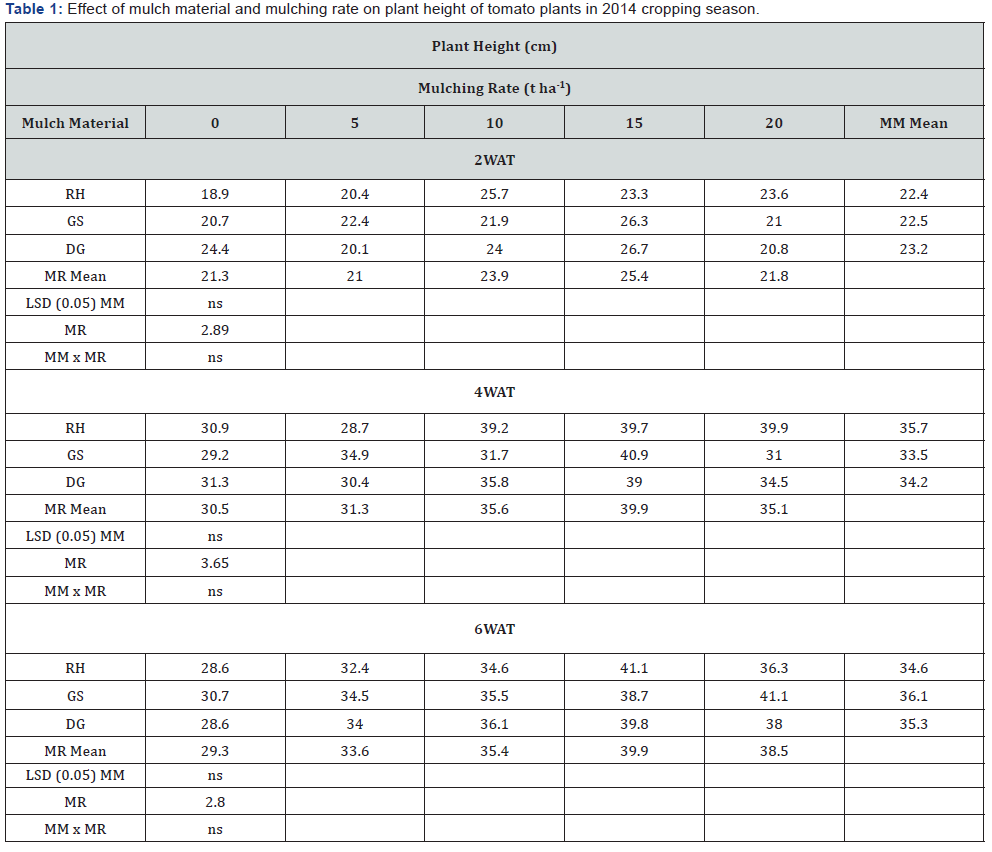
RH: Rice Husk; GS: Groundnut Shell; DG: Dry Guinea Grass; MM: Mulch Material; MR: Mulching Rate; NS: Not Significant; (P≤0.05); LSD: Least Significant Difference
At 4 WAT, plant height of tomato was significantly (P≤0.05) influenced by mulching rate. The plants mulched with 15t ha-1 (39.9cm) was significantly taller than other mulching rates while the least mean value (30.5cm) was obtained from the control plot which was not significantly different from the plants mulched with 5t ha-1 (31.3cm).
The plant heights of tomato was significantly (P≤0.05) increased by mulching rate at 6 WAT. The highest mean value (39.9cm) was obtained from the plants mulched with 15t ha- 1which was not significantly different from the plants mulched with 20t ha-1 (38.5cm). Also, the plants mulched with 10t ha-1 (35.4cm) and 5t ha-1 (33.6cm) was not significantly different from each other while the least mean value (29.3cm) was observed from the un-mulched plants. The interaction effects between mulch material and mulching rate at 2, 4 & 6 WAT were not significant (P≥0.05).
Number of flowers per plant
The mean number of flowers of tomato is presented in (Table 2). The number of flowers increased as the mulching rate increased and declined thereafter. The mulch material had no significant (P≥0.05) influence on the number of flowers of tomato plants. The plants mulched with 15t ha-1 (24.5) and 20t ha-1 (24.4) significantly had similar number of flowers which were significantly different from the plants mulched with 10t ha-1 (19.4) and 5t ha-1 (16.9). The plants mulched with 10t ha-1 was significantly higher than the plots left un-mulched (control) but significantly had similar number of flowers with the plants mulched with 5t ha-1, respectively. The interactive effects of mulch material and mulching rate was not significantly (P≥0.05) influenced.
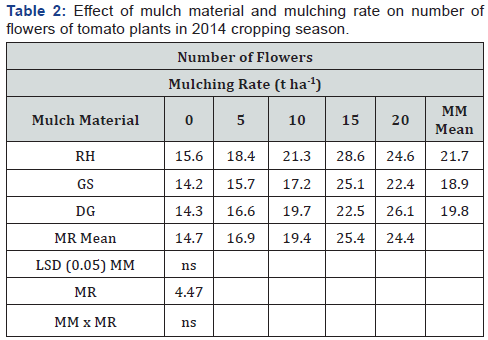
RH: Rice Husk; GS: Groundnut Shell; DG: Dry Guinea Grass; MM: Mulch Material; MR: Mulching Rate; WAT: Weeks After Transplanting; NS: Not Significant; (P≤0.05); LSD: Least Significant Difference
Number of fruits per plant
The mean number of tomato fruits is presented in (Table 3). The number of fruits increased as the mulching rate increased and declined thereafter. The mulch material had no significant (P≥0.05) effect on the number of tomato fruit. The mulching rate significantly (P≤0.05) affected the number of fruits. The plants mulched with 15t ha-1 (21.2) significantly gave higher number of fruits than the control plot (12.2), 5t ha-1 (14.0), and 10t ha-1 (14.6) but was not significantly different from that of 20 t ha-1 (18.8). The interaction effects of mulch material and mulching rate was not significantly (P≥0.05) influenced.
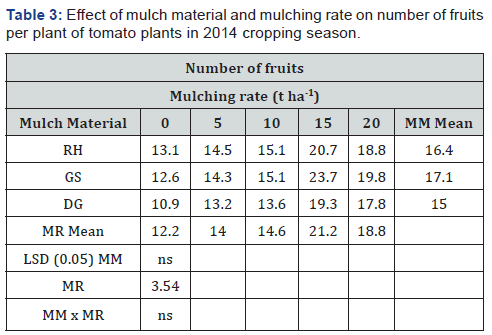
Total fruit yield (t/ha)
The total fruit yield of tomato increased as the mulching rate increased and declined thereafter as shown in (Table 4). The total fruit yield of the tomato was no significantly (P≥0.05) increased by mulch material treatments. The total fruit yield of tomato was significantly (P≤0.05) influenced by mulching rate. The plant mulched with 15t ha-1 (23.30t ha-1) was significantly higher than other values of mulching rates. Mulching rate of 20t ha-1 (17.57t ha-1) was significantly higher than the plants mulched with 10t ha-1 (11.90t ha-1), 5t ha-1 (10.80t ha-1) and the least was obtained from un-mulched plot (8.13t ha-1). But there was no significant difference between the values of these treatments. The interactive effect of mulch material and mulching rate was not significant (P≥0.05).

Soil temperature at 2 WAT
The mean soil temperature is presented in (Table 5). The soil temperature decreased as the mulching rate increased irrespective of the mulch material applied. Mulch material had no significant (P≥0.05) effect on soil temperature in the morning and afternoon at 2 WAT.
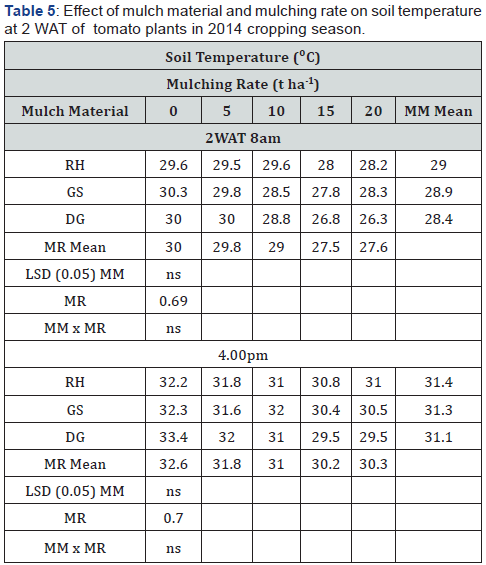
RH: Rice Husk; GS: Groundnut Shell; DG: Dry Guinea Grass; MM: Mulch Material; MR: Mulching Rate; WAT: Weeks After Transplanting; NS: Significant; (P≤0.05); LSD: Least Significant Difference
The soil temperature was significantly (P≤0.05) influenced by mulching rate in the morning. The un-mulched plots (control) recorded the highest soil temperature of 30.0 ⁰C which was significantly higher than the mean values (29.8 ⁰C, 29.0 ⁰C) obtained at 5t ha-1 and 10t ha-1 while the least mean value (27.5 ⁰C) was obtained from the plants mulched with 15t ha-1 which was not significantly different from that of 20t ha-1 (27.6 ⁰C). The same trend was observed in the afternoon soil temperature. Tomato grown in un-mulched plots significantly gave the highest mean value (32.6 ⁰C) which was significantly higher than the plants mulched with 5t ha-1 (31.8 ⁰C) and 10t ha-1 (31.2 ⁰C) and the least mean value (30.2 ⁰C) was obtained with 15t ha-1. The interaction of mulch material and mulching rate did not significantly (P≥0.05) influence morning and afternoon soil temperatures.
Soil temperature at 4 WAT
There was no significant (P≥0.05) effect of mulch material in morning and afternoon soil temperatures at 4 WAT (Table 6). Mulching rate had significant (P≤0.05) influence on soil temperature. In the morning, un-mulched plots recorded the highest mean value (30.1 ⁰C) which was significantly higher than the plants mulched with 10t ha-1 (28.9 ⁰C) but was not significantly different from the plants mulched with 5t ha-1 (29.4 ⁰C) while the least mean value (27.8 ⁰C, 27.6 ⁰C) were received from 15 and 20t ha-1. In the afternoon, the tomato plants left un-mulched recorded the highest mean value (32.3 ⁰C) which was significantly higher than the plants mulched with 5t ha-1, 10t ha-1 and 15t ha-1 while the least mean value (28.5 ⁰C) was obtained from the plants mulched with 20t ha-1. The interaction effects of mulch material and mulching rate on morning and afternoon soil temperatures were not significant (P≤0.05).
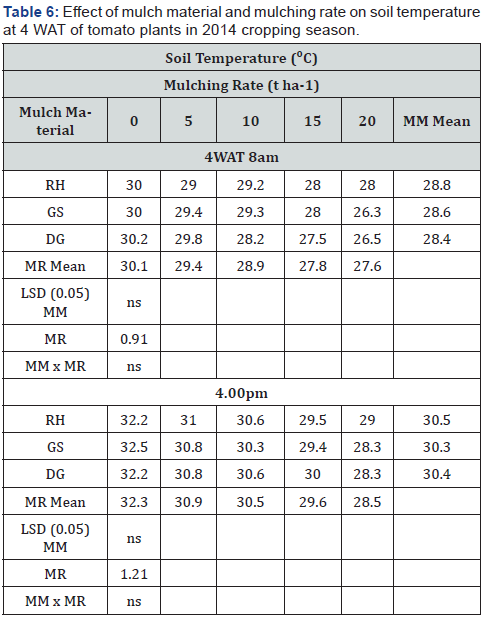
Soil temperature at 6 WAT
The mean soil temperature is presented in (Table 7). The mulch material had no significant (P≥0.05) effect on morning and afternoon soil temperatures at 6 WAT. The soil temperature was significantly (P≤0.05) influenced by mulching rate in the morning and afternoon soil temperatures. In the morning, unmulched plots significantly gave the highest soil temperature (31.8 ⁰C) which was significantly higher than the values of other mulching rates. The plants mulched with 5t ha-1 (29.7 ⁰C) and 10t ha-1 (29.3 ⁰C) was not significantly different from each other. The plants mulched with 20t ha-1had the least decreased mean value (28.5 ⁰C) which was not significantly different from that of 15t ha-1 (28.8 ⁰C). The interactive effects of mulch material and mulching rate was not significantly (P≥0.05) influenced.
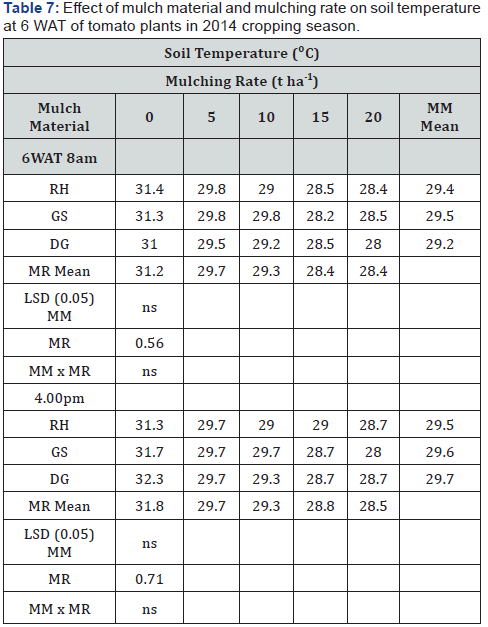
Soil moisture content at 2, 4 and 6 WAT
The mean soil moisture content is presented in (Table 8). Mulch materials had no significant (P≥0.05) effect on soil moisture content at 4 and 6 WAT. Mulch material had significant (P≤0.05) influence on soil moisture content at 2 WAT. Mulch materials of groundnut shell (3.3%) and dry guinea grass (3.1%) were not significantly different from each other but were significantly higher than the rice husk mulch (2.9%). The soil moisture content increased as the mulching rate increases from 0t ha-1 to 20t ha-1. Tomato plants mulched with 20t ha-1 (4.3%) was significantly higher than that of 15t ha-1 (3.7%) which was significantly higher than 10t ha-1 (3.1%) and 5t ha-1 (2.6%) while the least mean value (1.7%) was obtained from un-mulched plot.
The soil moisture content was significantly (P≤0.05) influenced by mulching rate at 4 WAT. Tomato plants mulched with 20t ha-1 (7.1%) was significantly higher than that of 10t ha-1 (4.8%) and 5t ha-1 (3.7%). But was not significantly different from 15t ha-1 (6.6%) while the least mean value (2.6%) was obtained from the control plot. Similarly, the same trend was observed at 6 WAT. The plant mulched with 20t ha-1 (6.6%) was significantly higher than the plants mulched with 10t ha-1 (5.2%) and 5t ha-1 (4.4%), respectively. But was not significantly different from that of 15t ha-1 (5.9%) and the least mean value (3.0%) was received from the un-mulched plot. The interaction effects of mulch material and mulching rate was not significantly (P≥0.05) influenced at 2, 4 and 6 WAT.
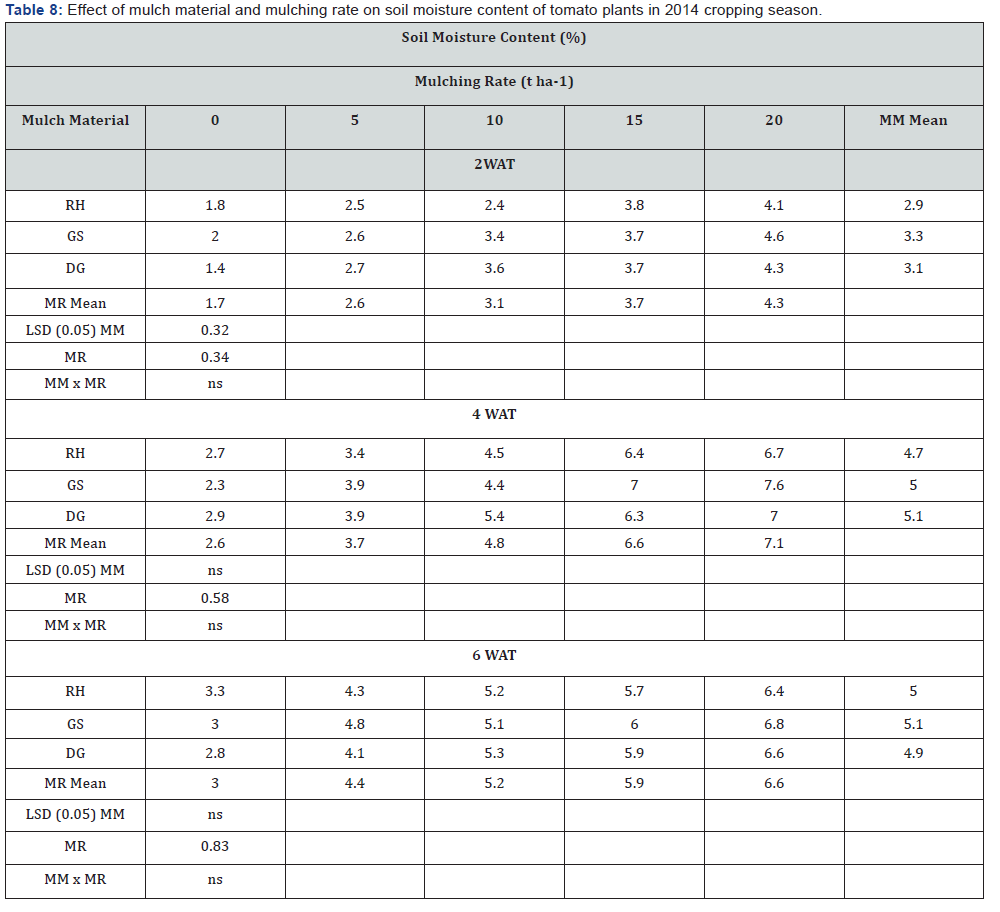
RH: Rice Husk; GS: Groundnut Shell; DG: Dry Guinea Grass; MM: Mulch Material; MR: Mulching Rate; WAT: Weeks After Transplanting; NS: Significant; (P≤0.05); LSD: Least Significant Difference
Discussion
Reports by Liasu & Abdul Kabir [8] stated that mulching is a layer of material on the surface of the soil used to keep soil moist or to serve a wide variety of purposes. Organic mulches are those derived from the dead plant and animal tissues, which apart from soil protection also serve as nutrient sources when they decay. Findings from Kayum et al. [9] revealed that mulching tomato plants with the use of water hyacinth, straw, am-ada leaf and banana leaf showed significant effect on growth and yield components and thus increase the yield. The significant plant height of 39.9cm obtained with the mulching rate of 15t ha-1 from the present study agrees with the report of Liasu & Abdul Kabir [8] who stated that tomato plants subjected to mulching exhibited the highest plant height when compared with control. The above authors in their findings also stated that the tomato plants subjected to mulching exhibited the highest number of leaves per plant than the control plot.
In the current study, mulching rate of 15t ha-1and 20t ha-1 produced number of flowers of 25.4 and 24.4 that were significantly higher than the values of other mulching rates. This may be attributed to the fact that the mulching application rate was higher thereby retaining moisture in the soil which promoted flower formation. This is in agreement with Anon [5] who reported that the thicker the mulch material the more water is retained in the soil to serve as a good medium for plant growth, development and efficient crop production. The results obtained from this study revealed that rice husk mulch gave higher number of fruits than other mulch materials. This agrees with the report of Akhtar et al. [6] who reported that natural mulches such as leaf, rice straw, dead leaves and compost have been used for centuries to increase fruit per plant, fruit length, fruit size, average fruit weight and yield. Findings in this study also agrees with those of Kayum et al. [9] who stated that mulching showed significant effect on growth, yield components and thus on the yield of tomato.
The significant highest total fruit yield of 23.30t ha-1 produced from the plants mulched with 15t ha-1 in this study was at the upper value of 14.00t ha-1reported by Gudugi et al. [14] and 21.47t ha-1 reported by Elkner et al. [16]. The results of the current study is in conformity with Ertek et al. [23] who revealed that mulching tomato plants at the rate of 10 to 20t ha-1 will give better yield using mulch materials such as green leaves, dried leaves and coconut fronds.
Findings from the current study indicated that rice husk mulch and mulching rate of 15t ha-1 significantly gave the decreased soil temperature of 27.5 ⁰C at 2 WAT which is in agreement with the findings of Anyanwu et al. [24] who reported that tomato is a warm season crop and it grows best at a temperature of 24 ⁰C -29 ⁰C under organic waste. This is also in line with Ajay & Shashi [20] who stated that soil temperature and yield of tomato was significantly improved with mulching over control.
The results obtained from the current study proved that groundnut shell and dry guinea grass mulches significantly increased the soil moisture content. This agrees with Brault et al. [21] who stated that traditionally, organic mulches such as dry grass and plant residue mulches are often used to warm soil early in the season. Soil mulching not only reduces the soil evaporation and weed growth but also improves the aerial environment around the plants which facilitate plant growth and yield. The result from the present study showed that the plants mulched with 20t ha-1 significantly gave better soil moisture content of 7.1% at 4 WAT. This reconfirmed Agbo [15] who stated that generally, the higher the amount of mulch applied, the better the water retention, growth and yield of okra. Similarly, Agele et al. [22] reported that mulching of sunflower plants with the organic mulch materials improved soil moisture status. They however, stated that dry grass and teak leaf increased soil moisture contents significantly over those obtained under polythene sheet mulch and control. They further revealed that soil moisture content improved considerably following decreased in soil temperature in plots mulched with dry grass and teak leaves.
Conclusion
Based on the research findings, it can be concluded that rice husk mulch gave better fruit yield and most reduced soil temperature while groundnut shell and dry guinea grass mulches recorded better soil moisture content. More so, the plants mulched with 15t ha-1 gave the highest fruit yield and the lowest soil temperature and the plants mulched with 20t ha-1 gave the highest soil moisture content. These therefore could be recommended for the tomato farmers within the study areas.
References
- Zeidan O (2005) Tomato production under protected condition. Ministry of Agriculture and Rural Development. The centre for International Agriculture Development Cooperation, pp. 43-44.
- Villareal RL (1980) Tomato in the tropics. West view Press Boulder, Colorado, p. 174.
- Omar Z (2005) Tomato production under protected conditions. Published by Mashav, Cinad co and the peres centre for peace project coordinator, pp. 71-112.
- Balarabe S (2012) Tomato production in Nigeria: issues and prospects. Ministry of Agriculture and Rural Development Kano, Kano State, Nigeria.
- Anon (2009) National Horticultural Research Institute. Annual Report for vegetable production.
- Akhtar S, Wahid A, Akram M, Rausl E (2001) Some growth, photosynthetic and anatomical attributes of sugarcane genotypes under NaCl salinity. International Journal of Agriculture and Biology 3(4): 439-443.
- Enan SA (2004) Effect of transplanting and soil application of boron and zinc on yield and quality of sugar beet. Ph.D. Thesis Al-Azhar University of Egypt, pp. 150-152.
- Liasu MO, Abdul kabir KA (2007) Influence of tithonia diversifolia leaf mulch and fertilizer application on the growth and yield of potted tomato plants. American-Eurasian Journal of Agriculture and Environmental Science 2(4): 335-340.
- Kayum MA, Asaduzzaman M, Haque MZ (2008) Effect of indigenous mulches on growth and yield of tomato. Journal of Agriculture and Rural Development 6(1 & 2): 1-6.
- Hooda RS, Singh J, Malik YS, Batra VK (1999) Influence of direct seedling, transplanting time and mulching on tomato yield. Vegetable Science 26(2): 140 -142.
- Bhagat RM, Acharya CL (1988) Soil water dynamics during wheat growth under different management practices. Journal of Indian Society. Soil Science 36: 389-396.
- Walter B (1988) Influence of bark mulch on water balance, soil water quality, mineralization and nitrification in skeletal Devonian viney and soils. Horticulture 59(9): 835.
- George A (2004) Horticuture principles and practices, pp. 709-710.
- Gudugi IAS, Odofin AJ, Adeboye MKA, Oladiran JA (2012) Agronomic characteristics of tomato as influenced by irrigation and mulching. Advances in Applied Science Research 3(5): 2539-2543.
- Agbo, Reginald Sitsofe Kwaku (2000) The effects of L. Leucocephala and G. Sepium mulches and their mixtures on the growth and yield of okra. Master of Science Degree Thesis, Kwame Nkrumah University of Science and Technology, Kumasi. pp. 44-45.
- Elkner K, Kaniszewski S, Gerasopoulos D, Passam H (1991) Effect of drip irrigation and mulching on quality of tomato fruits. Acta Horticulturae 379: 175-180.
- Norman QA, Clive AE (2005) Effects of vermicompost on plant growth. Paper presented during the International Symposium workshop on vermi Technologies for Developing Countries, Los Banos, Philippines, pp. 16-18.
- FAO (1999) Soil fertility initiation for Sub-Saharan Africa. World Soil Resource Reports 85: 82.
- Wood AW (1991) Management of crop residues following green harvesting of sugarcane in north Queensland. Soil and Tillage Research 20(1): 69-85.
- Ajay KS, Shashi K (2012) Effect of black plastic mulch on soil temperature and tomato yield in mid hills of Garhwal Himalayas. Journal of Horticulture and Forestry 4(4): 78-80.
- Brault D, Stewart KA, Jenni S (2002) Growth, development and yield of head lettuce cultivated on paper and polyethylene mulch. Horticultural Science 37(1): 92-94.
- Agele SO, Olaore JB, Akinbode FA (2010) Effect of some mulch materials on soil physical properties, growth and yield of sunflower (Helianthus annuus, L). Advances in Environmental Biology 4(3): 368-375.
- Ertek A, Sensoy S, Kuecuekyumuk C, Gedik I (2004) Agricultural water management 67: 63-76.
- Anyanwu AC, Anyanwu BO, Anyanwu VA (2001) A Textbook of Agricultural Science for Schools and Colleges Published by Africana- Feb Publishers Limited, pp. 71-75.






























